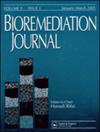Optimizing rapid pentachlorophenol biodegradation using response surface methodology
IF 1.9
4区 环境科学与生态学
Q3 ENVIRONMENTAL SCIENCES
引用次数: 0
Abstract
Abstract Pentachlorophenol (PCP) is one of the most toxic pollutants in the environment during modern industrial processes. Statistical experimental designs based on biological methods optimized the PCP biodegradation by Bacillus mucilaginosus and Pseudomonas plecoglossicida. Four factors were selected for PCP removal; glucose, ferric ammonium citrate, PCP concentration, and incubation period. PBD and CCD were performed to recognize the maximum PCP biodegradation. The maximum PCP biodegradation in PBD by B. mucilaginosus was obtained at glucose, 0.5 (g/l); ferric ammonium citrate, 0.5 (g/l); PCP concentration, 300 (mg/l) and incubation period, 3 (days) while the maximum conditions by P. plecoglossicida were glucose, 0.5 (g/l); ferric ammonium citrate, 0.5 (g/l); PCP concentration, 100 (mg/l) and incubation period, 3 (days). In addition, CCD predicted the optimum predicted degradation of PCP (100%) by the two selected strains using glucose (1.0 g/l), ferric ammonium citrate (0.059 mg/l), PCP concentration (350 mg/l), and 2-days for B. mucilaginosus. While glucose (0.276 g), ferric ammonium citrate (0.047 mg/l) and 2-days were optimal conditions for P. plecoglossicida. P. plecoglossicida.and B. mucilaginosus could degrade more than 72% and 61% of PCP when these isolates were grown under a high concentration of PCP (300 and 350 mg L−1) in a mineral salt medium, respectively.响应面法优化五氯苯酚的快速生物降解
本文章由计算机程序翻译,如有差异,请以英文原文为准。
求助全文
约1分钟内获得全文
求助全文
来源期刊

Bioremediation Journal
ENVIRONMENTAL SCIENCES-
CiteScore
5.30
自引率
0.00%
发文量
36
审稿时长
9 months
期刊介绍:
Bioremediation Journal is a peer-reviewed quarterly that publishes current, original laboratory and field research in bioremediation, the use of biological and supporting physical treatments to treat contaminated soil and groundwater. The journal rapidly disseminates new information on emerging and maturing bioremediation technologies and integrates scientific research and engineering practices. The authors, editors, and readers are scientists, field engineers, site remediation managers, and regulatory experts from the academic, industrial, and government sectors worldwide.
High-quality, original articles make up the primary content. Other contributions are technical notes, short communications, and occasional invited review articles.
 求助内容:
求助内容: 应助结果提醒方式:
应助结果提醒方式:


